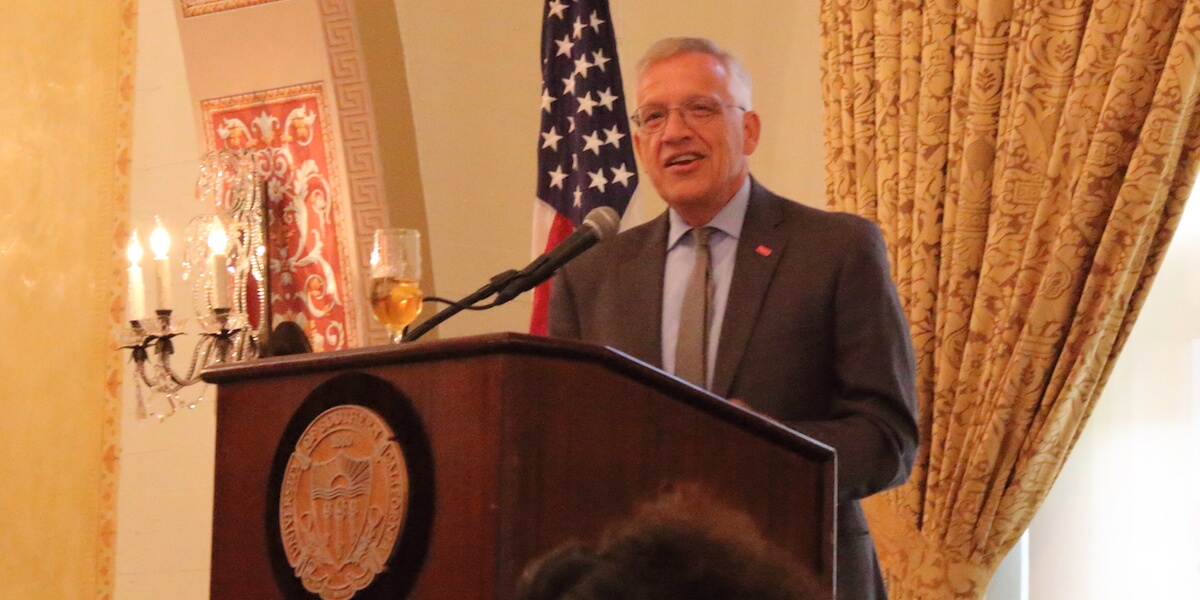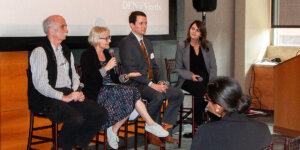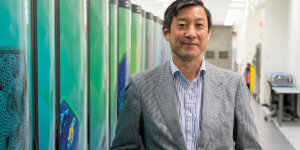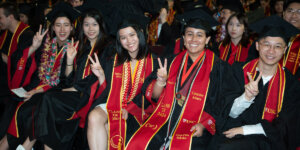
USC Viterbi Dean Yannis C. Yortsos (Photo/Dylan Cavaz)
In his Sept. 19, 2017 “State of the School” address, USC Viterbi Dean Yannis C. Yortsos discussed how technology is disrupting society as never before, forcing people and institutions to reinvent themselves or risk losing relevance. To remain “change agents,” the dean encouraged the faculty and staff members attending the lunchtime event at Town and Gown to embrace constant change and to adopt a growth mindset, an idea posited by Stanford University Psychologist Carol Dweck in “Mindset: The New Psychology for Success.”
Yortsos stressed USC Viterbi’s commitment to bringing together different disciplines to find solutions to society’s most intractable problems, through centers such USC Games (a partnership with Cinematic Arts), CAIS (the Center for AI for Social Good) and CHARIOT (the Center for Personalized Learning). He also noted the opening of the Michelson Center for Convergent Bioscience , a partnership with the Dornsife College. USC Viterbi, he added, is constantly “changing the conversation” about what engineers do, and what they look like through the diverse make up of its students and faculty, including an entering class that’s 44 percent female, 24 percent underrepresented and 13 percent first-generation.
In his 40-plus minute speech, the dean shared some breaking news with the assembled, announcing the creation of a new USC Viterbi-Keck School of Medicine partnership in neuroengineering to be led by newly recruited Gianluca Lazzi, a professor of ophthalmology and electrical engineering. Additionally, Yortsos spoke of the school’s leadership in the NAE Grand Challenges Scholars Program. Referring specifically to societal consciousness, one of the five competencies of the program, he said he hoped that in the near future USC Viterbi students, faculty and staff would volunteer at least 100,000 hours of community service a year. He also articulated a “parity principle” regarding the education, retention and graduation of all engineering students.
Here are some excerpts of the dean’s State of the School address:
On exponential growth and technology
“We live in times of exponential growth, driven by technology, which as the chart on your table shows, every year becomes higher and more empowering than the previous year. It looks roughly like this!

Now, the most important lesson one learns from this simple curve is that there are no longer what we call ‘steady states.’ (Such would arise when the curve in the schematic is relatively flat.) In fact, the very rate of change is not constant either. The tangent to the curve in your handout, what I have denoted as ‘society,’ shows how things would have evolved assuming a constant rate of change. To the present time, our organizations, our endeavors have historically been based on the assumption of a steady state – or in most enlightened organizations – on a constant rate of change. Consider politics, not exactly an enlightened field, where change has a time constant of say four years or even longer. It is not hard to see that in an exponentially changing world, the typical assumed rate of change of politics and policy results into an increasingly deeper chasm – also shown in the graph – one that we vividly experience today in the world. Such disruption is prevalent and surrounding us. The constant change brings up tremendous opportunities but also the possibility of being left behind fast.
This is our challenge and our opportunity, and it will be here every year. In order to shape and lead, in order to not be left behind, we have no option other than to reinvent ourselves every year. We must ‘hug the exponential.’ All of our pillars, which, by now, you all know, I am sure – talent, educational programs, research and innovation – all our supporting functions, from staff to communication and to fundraising, must constantly strive to stay on the exponential curve, to hug the exponential. Or, as I have mentioned to my team before, borrowing from the game of soccer: We must play as if the score is 0-0 regardless of how far ahead we might be.”
On the “growth mindset”
“Those with fixed mindsets believe that talents and abilities are fixed traits. Let’s say that such mindsets are the tangent to the curve. In his wonderful book, ‘The Contrarian’s Guide to Leadership,’ former USC President Steven B. Sample has a chapter that distinguishes between ‘Being President’ vs. ‘Doing President.’ The fixed mindset is that of ‘being.’
On the other hand, those with growth mindsets believe in constant growth and change. This is the mindset of ‘doing,’ of ‘becoming,’ of President Sample. The growth mindset is purposeful, with perseverance and resilience, devoid of debilitating stereotypes. It is about growth and passion. It drives innovation and renewal, and those with such mindset are the world’s change agents.
USC Viterbi has always been in the business of ‘doing’ and ‘becoming.'”
On convergence
“We have practiced this convergence for some time now. In fact, USC is the ideal university for convergence. Last time I counted, there were 19 USC deans, easily the largest for any university I am familiar with. The real significance of this is that there are 19 distinct disciplines presenting a unique opportunity and a great fortune for Viterbi students and faculty to establish unique convergence relationships with 18 or more disciplines. And this we have done in what we call Engineering + X.
Consider:
The Center for Artificial Intelligence in Society, or CAIS, is a synergy between USC Viterbi and the USC Suzanne Dworak-Peck School of Social Work – with Milind Tambe leading the Viterbi effort. It helps apply the power of AI to solving societal problems. CHARIOT is a new partnership between USC Viterbi and the Rossier School of Education, based on the use of IoT to enhance personalized learning (one of the 14 NAE Grand Challenges) – with Bhaskar Krishnamachari the Viterbi champion. USC Games, a partnership between the School of Cinematic Arts and USC Viterbi is the top program nationally in computer games, expanding to Virtual Reality (another of the 14 NAE Grand Challenges), thanks in large part to Mike Zyda’s leadership. The Center on Quantum Computing and Communication, involving the campus, Viterbi, Dornsife and the Information Sciences Institute (ISI), continues a growing effort in this exciting new frontier, led by Daniel Lidar. USC Viterbi and the Annenberg School collaborate on multimedia through IMSC and Cyrus Shahabi. While in the same areas, Professor Shri Narayanan works, among many other things, on quantifying how genders are depicted in the media. Maja Matarić, Terry Sanger, Mark Humayun and many other faculty have been involved for some time now in the intersection of engineering and medicine, including HTE@USC, whose 2.0 version we are currently undertaking. And along the same lines, I am pleased to announce the creation of a new Viterbi-Keck partnership in neuroengineering to be led by newly recruited ECE professor Gianluca Lazzi.”
On the Michelson Center
“On Nov. 1, the Michelson Center for Convergent Bioscience, will formally open its doors. This new convergence collaboration between Viterbi and Dornsife will be housed in the state-of-the art 165,000 square foot new building, which is the largest investment ever in USC history in science and engineering. Represented in the new building will be professors from biomedical engineering, such as Ellis Meng, Eun Ji Chung, Stacey Finley and Cristina Zavaleta; Professor Carl Kesselman from the Daniel J. Epstein Department of Industrial and Systems Engineering; Professor Niema Pahlavan from aerospace and mechanical engineering; Professor Fei Sha from computer science; while a core on protein engineering in the new facility will be directed by Rich Roberts, The Mork Family Department of Chemical Engineering and Materials Science chair.
More importantly, this facility will be open to all our faculty with nanofabrication and microscopy needs. USC Viterbi devoted considerable resources of its own to build a new modern nanofabrication center, to be named in honor of our late colleague John O’Brien. The new O’Brien Center will be directed by his worthy successor, Professor Andrea Armani, who will also have presence in the building. This is a truly convergent building indeed, likely unique in the nation.”
On the Information Sciences Institute
“For 45 years, the Information Sciences Institute has made an outsize contribution to advancing information processing, computer and communications technologies. Under Prem Natarajan’s outstanding leadership, the research institute continues being a trailblazer in advancing computer science in creative and groundbreaking ways and in service to the nation. Just this past year, ISI’s research expenditures have surpassed a record $100 million plus, ranging from secure electronics to forecasting and to quantum computing.
Now, as it celebrates its 45th anniversary, ISI is also expanding its geographic footprint, having recently opened a new Boston office, the first USC presence in the Boston area.”
On this year’s undergraduate class
“USC Viterbi has been a pioneer in this effort of changing the conversation, of doing instead of being. Consider: this year’s freshman class is nearly 44 percent women, an historic high for the school, which exceeded last year’s high of 39 percent. More than one-third of USC Viterbi undergraduates are female, much higher than the 20 percent national average. The entering class is 24 percent under-represented minorities and 13 percent first generation, both significantly higher than last year. Importantly and partly as a result of this diversity, our freshman class is the best in its history. In fact, this year was our most selective year since I have been at USC, with about 12,000 applicants vying for about 450 freshman slots. One-hundred-eighty-five students in our entering class are University Scholars; they come from 24 different countries and from 39 different states.”
On this year’s graduate students
“Our graduate programs are as robust as ever. We matched an all-time high of more than 16,100 applications both for our DEN@Viterbi and on-campus programs, making this fall’s graduate classes as selective as any in USC Viterbi since I can remember. More than 1,600 students in our graduate programs are women. And USC Viterbi enrolled the most women in graduate engineering programs than any other school in the nation.”
On the “parity principle”
“I would like to announce the adoption of a ‘parity principle.’ I will use a simple technical analogy to make it perhaps better understood. I tend to look at education as a chemical reaction process and the four to five-year curriculum as a chemical reactor. Then, as an engineer, I think that an important metric of highest possible efficiency is that the output should be similar if not identical to the input. More specifically, the demographics – gender, race, ethnicity – at the output should be about the same as that of the input, always assuming that when we admit students we have every confidence that they will be successful. But this principle of parity can only be applied if as an institution we take full ownership and accountability. If every institution in the country, from K-12 through graduate school, adheres to it, we can collectively change engineering. It is a principle I ask you to embrace, a principle I ask you to implement in all that you do, as teachers, researchers, staff, advisors and mentors.”
On diversity
“During the last several years, I have been the chair of the Diversity Committee of the Engineering Deans Council, in which capacity I helped lead a diversity initiative across the nation. As you may already know, this initiative is now signed by more than 210 Deans nationwide. This remarkable commitment entails efforts from K-12 to community colleges and faculty. Vice Dean Brandi Jones and her office will help us implement it here at Viterbi and coordinate nationally this important effort.
It is because of this mindset that the American Society for Engineering Education awarded USC Viterbi the ASEE President’s Award for 2017. This is the first such honor for USC and one of few ever bestowed to an engineering school.”
On educating students today
“As the exponential pace of the world continues, how we educate our students becomes increasingly challenging. The disruptive power of change can only be managed with, you guessed it, a growth mindset. The old and fixed education paradigm is increasingly becoming obsolete. The development of a growth mindset becomes increasingly more important, including how to make our own students adopt it and espouse it.
Bricks and mortars universities will likely be judged by their ability to provide culture, environment, increasingly interactive activities with peers and mentors that help develop talent with creativity, leadership and perseverance; in short, a growth mindset. Deep experiential learning, coaching and mentoring, activities outside the classroom, will become important elements of new education. It is our moral responsibility to ensure that our students are equipped with the skill-set and the attitude and mindset to be successful in a constantly changing world. The old and fixed mindset will simply not do anymore.”
On the Grand Challenges Scholars Program
In 2009, USC Viterbi partnered with Duke University and Olin College to launch the Grand Challenges Scholars Program. The program is based on acquiring five competencies: experiential learning through research and hands-on projects; interdisciplinary immersion, including communication; innovation and entrepreneurship business models; cultural awareness through global and other immersion; and societal consciousness.
With the end of the calendar year 2016, GCSP completed seven years of existence as a novel engineering undergraduate program. It has now been adopted by more than 50 engineering schools worldwide and actively considered by an additional 40 schools.
More importantly, the program is now a high priority of the NAE, which has hired dedicated staff to help move the program forward, and particularly to expand it globally. No less, the national leadership of the engineering professional societies gathered here at USC Viterbi yesterday to discuss ways through which elements of the GCSP will be coordinated through the professional societies. This is yet another illustration of the national and global leadership of USC Viterbi in leading the changing nature of engineering education.”
On the iPodia Alliance
“The iPodia Alliance, our innovative ‘global classroom’ initiative of joint classes across the oceans, now counts 13 schools, spanning four continents, with the University of Patras in Greece the newest member. This semester we have tried a global first, namely to offer the same class simultaneously to all members of the iPodia Alliance. A class spanning the Americas, Asia and Europe.”
On student innovation
“With the Maseeh Entrepreneurship Prize Competition; the Min Family Engineering Social Entrepreneurship Challenge; the USC Coulter Translational Research Partnership Program; and the Startup Garage Synchrotron accelerator, USC Viterbi students have more opportunities than ever to develop innovative business models, explore technology commercialization, and create inventions with impact. And I am particularly pleased to announce that this year’s Min Family Challenge will be dedicated to addressing the natural catastrophes brought by Hurricanes Harvey and Irma.”
Download the full 2017 State of the School address here
Published on September 22nd, 2017
Last updated on April 5th, 2025












